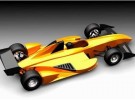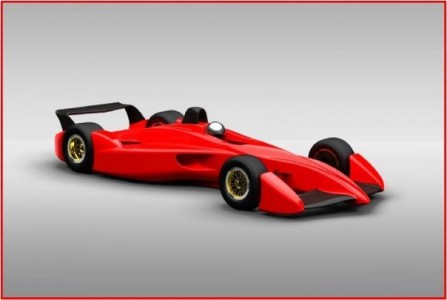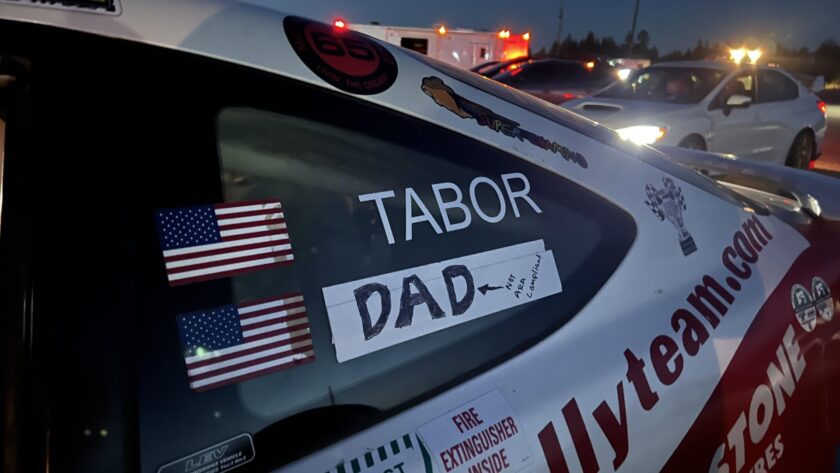Perhaps in response to all of the DeltaWing buzz, and in an effort to take some of the thunder away from the DeltaWing reveal on February 10th, Dallara has revealed images of three concepts for the 2012 IZOD IndyCar Series chassis. The three concepts center around three different design philosophies: one a traditional evolutionary design, one a conservative but evolutionary design, and one more radical evolutionary design. Let’s examine each one separately in light of the recently revealed, but not surprising, new chassis objectives:
- Safe,
- Raceable,
- Cost-Effective,
- American Made
- Less Mass / More Efficient,
- Relevant Technology,
- Modern Look,
- Green.
First of all, all concepts, as reported by Dallara, will all be safe (a total must), and cost significantly less than the current chassis, they can all be made less massive and therefore more efficient, made with relevant manufacturing methods and materials, and constructed using environmentally sensitive techniques and practices. Plus, Dallara has already claimed that their 2012 chassis will be built in Indianapolis. Let’s set those aside as givens and examine the remainders, Raceable and Modern Look. The league mentions under “Modern Look” that the car has more room for sponsor logos. I don’t necessarily thing that more room for decals equates to a modern look, but we’ll go with their definitions for the purpose of this evaluation.
Traditional Evolution – The Maroon Car

Raceable: C+
This concept, being more of an evolution rather than a revolution of design, should have the same level of raceabililty as the current design. One would hope, however, that with the reduction in mass and keeping Honda at their word of a 575-hp engine, the overall speed on ovals and performance on road courses should be improved. The biggest flaw of the current design in this category is its lack of drive out of the slow corners on the road and street circuits. Whether the car will be raceable on ovals, that is allowing drafting, slip-streaming, and wheel-to-wheel racing, is something that cannot be fully evaluated until the car is on track. The most that can be done is to examine the wake turbulence in a wind tunnel, or model it via CFD. One improvement that this and all of the proposed concepts have is a measure of protection and encasement of the rear wheel. This will minimize the possibility of a wheel-to-wheel collision resulting in the spinning or worse flipping of a car as we saw most spectacularly with Dario Franchitti at Michigan in 2007, and tragically with Vitor Meira at Indianapolis in 2009. The rear section of the rear wheel is still exposed, however, so a driver running their front wing into the rear tire of a competitor, thus creating a puncture, is still a risk.
Modern Look: B-
This car, although an improvement to the past-its-prime current chassis, doesn’t really strike out in a new and innovative design direction. It appears much like the current style of any single-seater formula car racing today. Although the lines on this concept are smoother, there’s no real difference between this and the current chassis except for the removal of the large air intake, and the inclusion of a shark-fin. That shark-fin does offer an added opportunity for sponsorship placement, however, its not an especially modern design element. Reynard was using them back in the mid-90s on their chassis. The shark-fin on the concept versus the airbox on the current chassis probably equate to the approximately the same amount of area. The shark-fin is vertical and flat, so the nod goes to it as being the superior surface for decals, but only just. Overall, this is a slight improvement and modernization of the current chassis appearance, but its certainly not a great leap forward.
Conservative Revolution – The Yellow Car

Raceable: B+
Many of the comments I made about the Maroon Car regarding raceability certainly apply to this car as well. The car needs to have a smooth wake, and since the rear end of this car isn’t entirely unlike the current style for most formula racers, I’m not going to expect any surprising differences in that regard one way or the other.  One area where the concept appears to be a significant improvement its subtle protection of the wheels. While maintaining a very definite open-wheel appearance, the sidepods extent enough forwards that the front wheels are protected to a degree from intrusion from another car. The rear tire is still exposed and vulnerable to being cut down by a front wing, but the important feature is the reduction of the risk of a wheel-to-wheel (tread-to-tread) collision at high speed.
One area where the concept appears to be a significant improvement its subtle protection of the wheels. While maintaining a very definite open-wheel appearance, the sidepods extent enough forwards that the front wheels are protected to a degree from intrusion from another car. The rear tire is still exposed and vulnerable to being cut down by a front wing, but the important feature is the reduction of the risk of a wheel-to-wheel (tread-to-tread) collision at high speed.
Modern Look: A
This concept direction introduces a car that is somewhere in between being revolutionary and evolutionary. It still has many of the same design features as any current formula car, but with much more aggressive design of the sidepods. The sloped sidepods minimize the amount of vertical space on the car for decals, but maximizes the amount of single-plane surface area on top of the sidepod. Also, with the top surface being angled, that surface will be positioned to be seen very easily by fans in grandstands and by cameras on their skylifts. If the league wants a car that looks cool, but still looks like an open-wheel formula racer, and has abundant space for sponsorship decals, then this is a winner. Its even possible that the subtle dorsal fin that the concept sports could be extended into a broader shark-fin, thus opening up even more space for decals.
Radical Revolution – The Red Car

Raceable: B-
This design offers several possible improvements to the raceability. Sure, I understand that you can’t really judge much without at least running some CFD, but this design removes many of the elements from the rear quarter of the car that can generally lead to increased turbulence. Notice that the rear wing is supported at the ends, immediately behind the rear wheels. This frees up the rest of the rear to be smoothed and streamlined. Notice also that the rear tires are all but fully encased. The rear of the car is fully protected by body work so there’s less risk of a competitor’s front wing cutting down your tire. The rear of the front tire, however is still fully exposed, even more so than in the evolutionary design of the Maroon Car. The ends of the front wings do have more substantial nodules on them, but those will be ripped off in a heartbeat when they come in contact with a tire tread moving at 230 mph. The way in which the rear is fully protected while the front is fully exposed will induce colliding cars to spin more so than either of the other two designs. I’d put this slightly above the first concept in terms of its potential raceability due to the cleaning up of the rear section of the car, but the potential for interlocking front wheels is a serious drawback.
Modern Look: B
This is certainly the more radical design of the three. When I look at this, my first thought was that Dallara threw this concept out as a DeltaWing killer. After all, when we look at the overhead view, it is exactly that, a delta wing configured car.  The concept gets props for being very radical and modern looking, even to the point of looking like a Hot Wheels car, but where it fails is in offering substantial usable space for sponsorship decals. Upon first look, one might rebut my claim by pointing out the huge amount of surface area on rear deck and top of the sidepods of the car. My response would be that yes there is a lot of surface area there, but its all oriented in exactly the wrong way. Keep in mind the angle at which we typically see these cars on TV or from the stands. We’re not exactly looking right at the side of the cars, but we’re not staring straight down from overhead either. In spite of the increased amount of area, the amount of actual productive surface doesn’t increase much beyond the current chassis.
The concept gets props for being very radical and modern looking, even to the point of looking like a Hot Wheels car, but where it fails is in offering substantial usable space for sponsorship decals. Upon first look, one might rebut my claim by pointing out the huge amount of surface area on rear deck and top of the sidepods of the car. My response would be that yes there is a lot of surface area there, but its all oriented in exactly the wrong way. Keep in mind the angle at which we typically see these cars on TV or from the stands. We’re not exactly looking right at the side of the cars, but we’re not staring straight down from overhead either. In spite of the increased amount of area, the amount of actual productive surface doesn’t increase much beyond the current chassis.
The Wrap-up:
So in the end, which one is best? Well, all of the above is purely speculation and my s.w.a.g. at the aerodynamic profiles, and thoughts based on my minimal understanding of design. However, that’s never prevented me from sharing my opinion on matters before, and it won’t stop me now. My vote is for the Yellow Car concept. The combination of being different enough to be new and exciting while still retaining many of the cues that allow people to immediately identify the car as an IndyCar, and the abundance of usable surface area for sponsorship representation makes the design a winner for me. The design of the sidepods to minimize the risk of tread-to-tread wheel contact is another major advantage which takes the car well beyond the other two concepts in terms of both raceability and safety. Now we just have to wait to see what DeltaWing, Lola, and Swift bring to the table. I’m sure we’ll see variations of the three themes Dallara expressed, but it will be interesting to see the different manufacturer’s interpretations. What ever the final design is for the league, a decision needs to be made and soon!




Brilliant article doug and a very nice breakdown on all the concepts. I too think the yellow car is the best option and looks to satisfy all of the minimum requirments expressed by the league. However, you are right…we won’t know until some CFD and actual on track testing is complete.
Maroon #1 – NO! That is just a stylized version of the current Dallara with one of those garbage shark fins on the back. Lets leave those gimmick wings over in F1. As much as the current chassis is denigrated for its lack of aesthetic appeal, this updated version of the current car is not a new design direction.
I like yellow #2 and red #3. Both need to be cleaned up a bit before they are ready for primetime though.